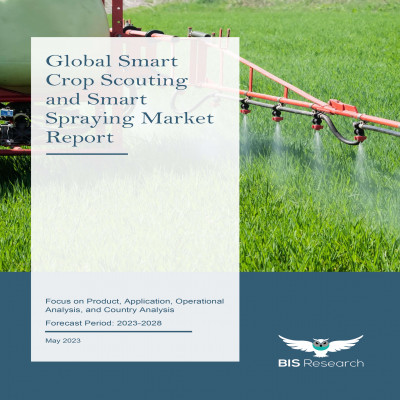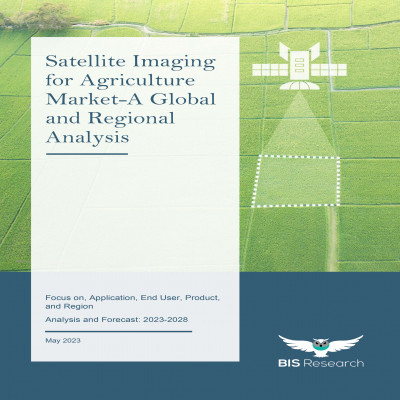Imaging Technologies for Precision Agriculture Industry and Technology Overview

Introduction to Imaging Technologies for Precision Agriculture
The global imaging technologies for precision agriculture market size was $885.0 million in 2022, and with a CAGR of 11.27%, it is expected to reach $1,690.6 million by 2028. The adoption of imaging technologies in agriculture is driven by multiple factors. Firstly, the need for precision and efficiency pushes farmers to optimize their agricultural practices by utilizing data-driven insights from imaging technologies, enabling them to identify crop health issues and apply targeted treatments. Secondly, these technologies offer cost savings by reducing excessive resource usage, minimizing chemical inputs, and lowering labor costs through automation. Thirdly, imaging technologies contribute to environmental benefits by promoting sustainable farming practices, reducing chemical runoff, and preserving natural resources. Lastly, in the face of climate change, these technologies aid in continuous crop monitoring, assisting farmers in adapting to changing conditions and ensuring food security. Overall, these factors combine to accelerate the adoption of imaging technologies in precision agriculture.
Market Introduction
Imaging technologies in precision agriculture involve the use of various sensors and cameras to capture detailed information about crops, soil, and other environmental factors. These technologies enable farmers and agronomists to monitor and analyze crop health, detect diseases, assess nutrient levels, and identify pest infestations with a high level of accuracy. Aerial and ground-based imaging solutions are used for crop monitoring, soil mapping, and climate monitoring.
Impact
Increased Productivity and Yield: Imaging technologies such as drone-based imaging and satellite-based sensors provide real-time insights into crop health and growth patterns. Farmers can detect early signs of diseases, nutrient deficiencies, or pest infestations, enabling them to take timely action. By addressing these issues promptly, they can improve crop health and achieve higher yields, maximizing their overall productivity and profitability.
Resource Efficiency and Cost Savings: Through imaging technologies, farmers can map variations in soil health and moisture levels across their fields. This data helps them tailor irrigation and fertilizer applications precisely to meet crop requirements, reducing waste and optimizing resource utilization. By using inputs more efficiently, farmers can save costs on excess chemicals and fertilizers, contributing to higher profitability and sustainable agricultural practices.
Sustainability and Environmental Benefits: Imaging technologies promote sustainable farming practices by minimizing the use of agrochemicals. With the targeted application of fertilizers and pesticides, there is less runoff into water bodies, reducing water pollution. Additionally, optimizing irrigation lowers water consumption, conserving this valuable resource. These practices contribute to environmental preservation, soil health improvement, and a reduction in the overall ecological footprint of agriculture.
Data-Driven Decision-Making and Precision Agriculture: The data collected through imaging technologies provides valuable insights into crop performance and field variability. Farmers can analyze this data to make informed decisions on planting, harvesting, and resource allocation. Precision agriculture techniques, enabled by imaging technologies, involve prescription mapping, variable rate technology, and automated machinery. These strategies streamline farming operations, enhance efficiency, and ultimately lead to more sustainable and productive agricultural systems.
Market Segmentation:
Segmentation 1: by Application
• Crop Monitoring
• Soil Mapping
• Climate Monitoring
Crop Monitoring to be the Largest Application Segment for Imaging Technologies over the Forecast Period
Crop monitoring was the largest application segment for imaging technologies and generated revenue of $631.0 million in 2022 and is expected to reach $1,238.8 million. This trend can be attributed to the rising focus of the growers on crop health and the need to adopt precision agriculture practices. Imaging technologies provide real-time insights into pest and disease detection, enabling targeted interventions and cost-effective solutions for farmers. Technological advancements, such as drones and hyperspectral imaging, have made these tools more accessible and data-driven, empowering farmers to make informed decisions. Moreover, the unpredictable impacts of climate change on agriculture have emphasized the need for continuous crop monitoring, further fueling the adoption of imaging technologies in the agricultural sector. Government support and initiatives aimed at promoting sustainable farming practices have also contributed to this growing demand.
Segmentation 2: by Crop Monitoring
• Nutrient Analysis
• Yield Prediction and Estimation
• Pest and Disease Detection
• Weed Detection
Imaging Technology in Crop Monitoring Being Used for Pest and Disease Detection
Imaging technology plays a pivotal role in crop monitoring, with its primary application being pest and disease detection. By harnessing the power of advanced sensors and imaging techniques, farmers can swiftly and accurately identify early signs of infestations or diseases in their crops. This timely detection empowers them to implement precise interventions, such as targeted spraying or localized treatments, minimizing the spread of pests and diseases and optimizing the use of agrochemicals. As a result, imaging technology not only enhances crop health and yields but also promotes sustainable and eco-friendly farming practices by reducing unnecessary chemical applications.
Segmentation 3: by Technology
• Aerial Imaging
• Ground-based Imaging
Aerial Imaging Technologies to Remain the Largest Technology Segment during the Forecast Period
Aerial imaging technology has emerged as one of the largest segments in the precision agriculture imaging technologies market, generating revenues of $610.5 million in 2022 and projected to reach $1,197.5 million by 2028. Aerial imaging offers the advantage of wide area coverage. Drones or manned aircraft equipped with imaging sensors can swiftly survey vast agricultural landscapes, providing farmers with a comprehensive view of their fields. This capability enables efficient monitoring and timely detection of crop health issues, pest infestations, or nutrient deficiencies across large areas, which would be challenging to achieve through ground-based methods.
Technology has witnessed significant advancements in recent years, leading to the capture of high-resolution imagery. High-resolution aerial images deliver detailed insights into crop conditions, soil variability, and other critical parameters. This granular data empowers farmers to make precise decisions, optimize resource allocation, and implement targeted interventions to improve overall farm productivity.
Moreover, aerial imaging has become increasingly cost-effective compared to traditional approaches such as manned flights or satellite services. The advent of sophisticated yet affordable drone technology has democratized access to aerial imaging for farmers of all scales. This accessibility has led to wider adoption of the technology across diverse agricultural operations.
Segmentation 4: by Region
• North America - U.S., Canada, and Mexico
• Europe - Germany, France, Italy, Spain, Netherlands, Belgium, Switzerland, and Rest-of-Europe
• China
• U.K.
• Asia-Pacific - Japan, India, Australia and New Zealand, and Rest-of-Asia-Pacific
• South America - Argentina, Brazil, and Rest-of-South America
• Middle East and Africa - Israel, South Africa, Turkey
Imaging technologies for precision agriculture demand is expected to experience the highest growth at 12.85% CAGR during 2023-2028 in the Asia-Pacific region due to factors such as increasing adoption of smart farming practices, rising awareness about the benefits of precision agriculture, government initiatives promoting agricultural technology, and the need to address food security challenges in the region. These factors are encouraging farmers and agricultural stakeholders in the Asia-Pacific to invest in advanced imaging technologies for enhanced crop monitoring and management, leading to significant market expansion.
North America and Europe are expected to dominate the imaging technologies for precision agriculture market during the forecast period. This is attributed to the high adoption rate of advanced agricultural technologies, government support for precision farming practices, well-established infrastructure, and the presence of major agribusinesses investing in precision agriculture solutions. Additionally, the growing focus on sustainable farming, efficient resource utilization, and increasing demand for high-quality agricultural produce is further expected to drive the market's growth in these regions.
Recent Developments in the Global Imaging Technologies for Precision Agriculture Market
• In December 2022, Lindsay Corporation, a global manufacturer and distributor of irrigation equipment, announced a strategic partnership with Ceres Imaging. The collaboration would integrate Ceres Imaging's high-resolution imagery and analytics into Lindsay's FieldNET platform, enhancing remote monitoring, control, and analysis of irrigation.
• In July 2021, Resonon launched the Pika UV hyperspectral camera. This unique instrument scans ultraviolet light in the 330-800 nm spectral range, making it the only commercially available ultraviolet hyperspectral imaging device.
• In January 2021, AgEagle Aerial Systems Inc. announced its agreement to acquire MicaSense, Inc. from Parrot in a deal valued at $23 million. AgEagle is a prominent provider of drone systems and solutions, and the acquisition of MicaSense, a company specializing in multispectral imaging solutions for agriculture, would further enhance AgEagle's capabilities in the agricultural drone market.
Demand – Drivers and Limitations
Market Demand Drivers: Global Imaging Technologies for Precision Agriculture Market
• Efficient Resource Management
• Need for Data-Driven Decision Making
• Climate Change and Extreme Weather Events
Market Challenges: Global Imaging Technologies for Precision Agriculture Market
• Adoption and Awareness
• Infrastructure and Connectivity
Market Opportunities: Global Imaging Technologies for Precision Agriculture Market
• Growing Precision Agriculture Adoption
• Customization and Tailored Solutions
Analyst’s Thoughts
According to Debraj Chakravarty, Principal Analyst at BIS Research, “The integration of advanced imaging tools, such as multispectral and hyperspectral cameras, drones, and satellite imagery, has revolutionized how farmers monitor and manage their crops. Moreover, imaging technology facilitates precision agriculture practices. With the ability to capture high-resolution images of fields, farmers can precisely assess crop variability and tailor their interventions accordingly. This would eventually lead to optimized resource utilization, reduced environmental impacts, and improved overall productivity.”




